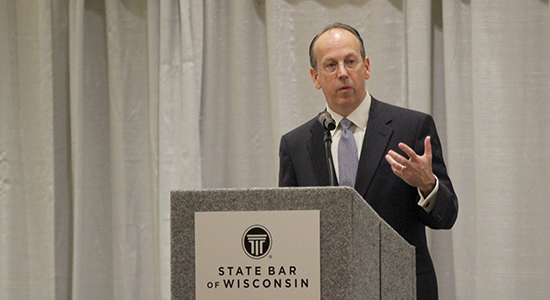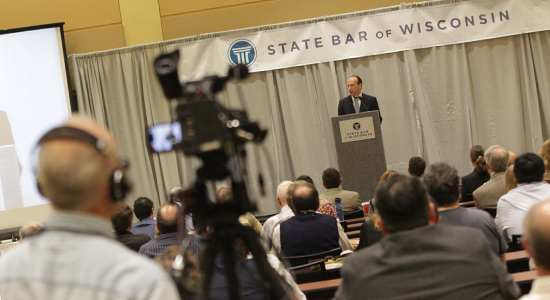
June 17, 2016 – If you heard attorney Paul Clement’s presentation yesterday on “The Roberts Court” at the State Bar of Wisconsin’s Annual Meeting and Conference (AMC), you are smarter now and understand why he is one of the nation’s top advocates.
Clement, a former U.S. Solicitor General (2005 to 2008) who has argued 83 cases before the U.S. Supreme Court, including six this last term, basically wrote an oral law review article with no notes – just knowledge and engaging Midwestern charm.
Clement is a Wisconsin native, a Green Bay Packer fan, and a member of the State Bar of Wisconsin after all. Overheard at the conclusion of Clement’s presentation in Green Bay: “I just kept thinking the whole time, this man should run for President.”
Before diving deep into the Roberts Court, Clement noted that he had occasion to reference Green Bay Packer Quarterback Aaron Rodgers while representing the NFL in the “Deflategate” case against the New England Patriots’ Tom Brady.
“The predicate rule that was arguably violated was the rule that footballs have to be inflated within a certain range,” Clement explained. “The judge wanted to know why deflating a ball would serve a tactical advantage. I said it was a matter of preference.
“I said some people prefer the ball to be underinflated, like Mr. Brady, and others prefer it to be relatively inflated, like Mr. Rodgers. It was a non-gratuitous reference to Aaron Rodgers, and I was pretty pleased with that afterwards,” joked Clement, now a private practitioner at Bancroft PLLC in Washington, D.C.
Justice Antonin Scalia
Clement, former law clerk to U.S. Supreme Court Justice Antonin Scalia, began by discussing the impact and legacy of his former boss, who died in February, leaving a vacancy, an eight-member Court, and political jousting on who will fill the seat.
Clement said one cannot talk about the Roberts Court, headed by U.S Supreme Court Chief Justice John G. Roberts Jr. since 2005, without talking about three decades of Justice Scalia, a President Ronald Reagan appointee who joined the Court in 1986.
Clement said there’s a general consensus among U.S. Supreme Court practitioners and commentators, across the political spectrum, that Justice Scalia was no ordinary justice, but an oversized presence on the Court with far-reaching and substantial impact.
“People can disagree whether the impact was positive or negative, but I think there is broad consensus that his impact really was very substantial,” Clement said.
For one, Justice Scalia transformed the enterprise of statutory interpretation, Clement said. “That’s a particularly important development if you think about it because on a day-to-day basis, statutory construction is really what the U.S. Supreme Court does.”
Want to see the exclusive post-presentation video interview with Paul Clement?
Check out the State Bar’s Facebook page (interview cuts off at about the 13-minute mark, due to technical difficulties. Full interview will be posted soon). Also, check out the State Bar’s Q&A with Paul Clement, from the May 4 edition of InsideTrack.
He said the Court’s constitutional cases grab news headlines, but about 70 percent of the docket involves statutory construction. “So a justice that can change the dynamic of statutory interpretation has really had a very significant impact on the Supreme Court.”
Before Scalia joined the Court in 1986, Clement said, it was not unusual for the Court in the 70s and 80s to decide a statutory construction case where the statutory text didn’t really figure into the decision. The Court looked more to legislative history and congressional records to determine the policy that Congress was trying to achieve.
But Justice Scalia changed that.
“Justice Scalia refocused the entire Court on the primacy of the statutory text in interpreting statutes,” Clement said. “I think that’s had a trickle-down effect through virtually all the federal courts such that if you are involved in a statutory case, you have to have an argument about why you win on the text before you go on to other sources.”
Scalia also had a distinct idea on constitutional interpretation, Clement noted. That is, he urged the Court to look at original public meaning. “He’s sometimes loosely described as an originalist, but the justice actually cared no more about the secret original intent of the Framers than he did about the intent of any one legislator. What he was focused on is what the words in the Constitution meant at the time.” He was focused on that, Clement said, because that’s what the states thought it meant at the time of ratification.
Scalia also influenced the Court, particularly in the area of criminal law, Clement noted. He noted a case in which Justice Scalia explained that “dispensing with the right to confront witnesses just because the evidence is reliable is akin to dispensing with the criminal defendant’s right to trial by jury just because the defendant is obviously guilty.”
Clement also noted Scalia’s transformative effect on the Court’s practice in oral arguments. Listen to oral arguments before Scalia arrived, Clement noted. “You will be struck with how relatively few questions the justices had for counsel, and how much air time the advocates had to share their thoughts and prose with the U.S. Supreme Court.”
The hot court traces back to Scalia, Clement said, noting that Scalia came from an enormously talented D.C. Circuit, with judges who were “vipers” when it came to oral argument. “They were really active and engaged with the advocate and each other.” He said Scalia continued that practice at the Supreme Court, and it was “contagious.”

The Roberts Court
Clement said the Court is noticeably less active since Scalia’s passing. “It’s not just the questions that Justice Scalia asked, but it’s the questions from other justices that his questions prompted. Because he had such a distinctive view,” Clement noted.
For the current term, Scalia’s passing also means the Court could split 4-4 on decisions that come out in the coming days and weeks. The court is divided in roughly 25 percent of cases, he noted, and there are essentially three options now when that happens.
The Court can simply issue a per curiam opinion that affirms the lower court, and it has done that in two cases so far, including a First Amendment case involving a challenge to compulsory dues collected by public unions. The only issue was whether to overrule a prior U.S. Supreme Court decision. With Scalia, that case was likely to be overruled.
“In some ways, that was an easy case for the Court to leave the lower court decision in place. The law didn’t change,” Clement said. “But there are other cases that are hard to leave a lower court decision in place.”
That’s true when there’s a circuit split. Leaving a lower court decision in place leaves the law in disarray, Clement said. He said another option for a divided Supreme Court is to decide the case on narrow grounds. That happened in the closely watched contraception case that Clement argued on behalf of nonprofit religious groups.
“Something strange happened. The court issued a supplemental briefing order. It looked like something a magistrate might issue to get parties to try and settle the case,” said Clement, noting the order suggested the parties could possibly reach an agreement.
 Joe Forward, Saint Louis Univ. School of Law 2010, is a legal writer for the State Bar of Wisconsin, Madison. He can be reached by email or by phone at (608) 250-6161.
Joe Forward, Saint Louis Univ. School of Law 2010, is a legal writer for the State Bar of Wisconsin, Madison. He can be reached by email or by phone at (608) 250-6161.
“It’s been described as a punt. But it is a punt with real substantive teeth because a punt does not vacate four lower court decisions,” noted Clement.
As a third option, the Court could also hold cases over for re-argument when the court is back to nine justices. “Whether they will or not is something we will probably learn at the end of the month,” said Clement, noting the Court has held over major cases before.
“But I think the Court is cognizant that holding a case over may not accomplish that much, because it’s not clear when the Court will get a ninth justice,” he said.
Clement said a shorthanded Court also dramatically impacts the number of cases the Court decides to accept for the next term. Currently, the Court has only accepted 14 or 15 cases, which is half the amount it has normally accepted by this time of year.
The reason, in part, is that it’s harder to get the four votes needed for certiorari, Clement noted. “Perhaps the bigger explanation, though, is that the court is reluctant to take cases in circumstances in which the Court could be divided 4-4.”
Clement also discussed in detail a number of other cases decided this term and commented on how the Court may change with a new justice in the future.
“I don’t know what lies ahead,” Clement said. “But I do think that people will look back and think of this 10 years, the 10 years when Justice Scalia was on the Court, the 10 years where Justice Alito replaced Justice O’Conner … this period of the Roberts Court will be seen as distinct and Justice Scalia’s passing will be seen as an inflection point.”
Clement highlighted the possibility of Merrick Garland, current judge for the U.S. Court of Appeals for the D.C. Circuit (where Scalia once sat), becoming a U.S. Supreme Court justice (his nomination is pending). He noted that Garland could actually move the Court to the right on many important issues in criminal law, with a reputation as a moderate justice. “Much of his moderation has been earned in criminal cases,” Clement noted.
